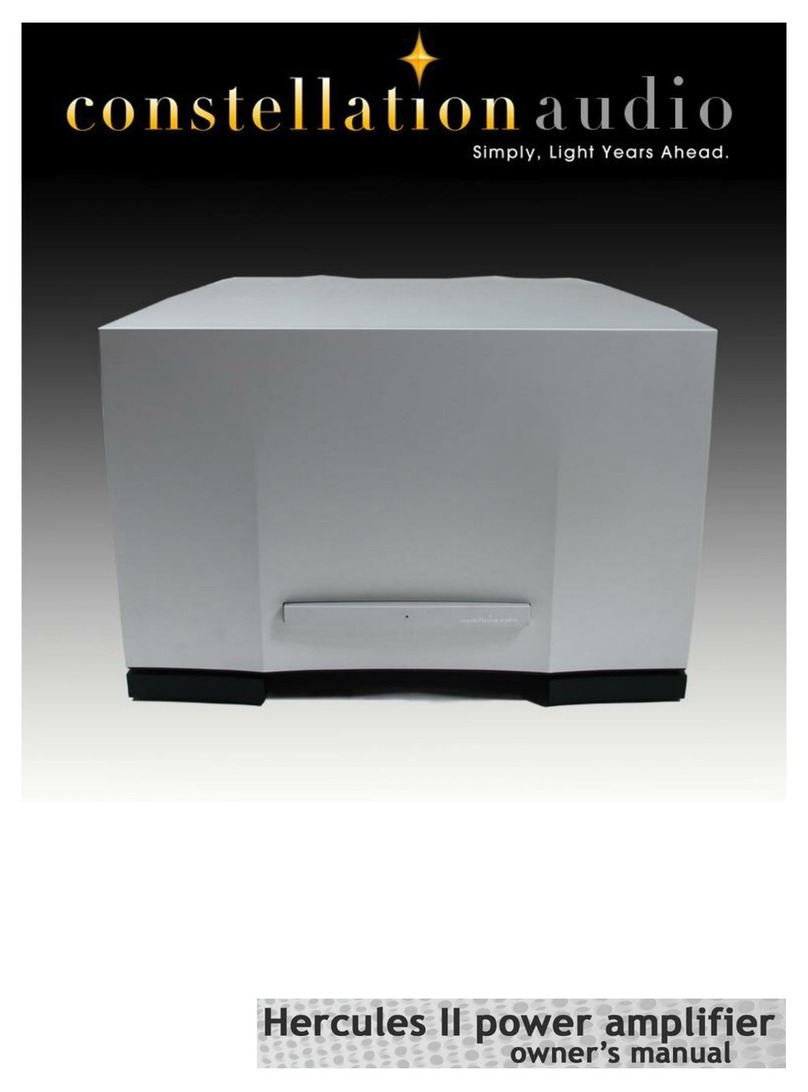
Installation notes
The Virgo II preamplifier uses passive cooling; there are no internal fans. While the Virgo II does not generate
as much heat as an amplifier, it should still be located in an area with adequate ventilation.
There should be at least 6 in/15 cm of clearance between the sides and top of the preamp and the nearest
wall or cabinet. If the Virgo II is installed in a cabinet or an equipment closet, ensure the cabinet/closet has
adequate ventilation. Installation in an unventilated cabinet or closet may cause the Virgo II to overheat,
significantly reducing its lifespan.
The Virgo II requires a room-temperature environment to operation properly. Ambient temperature should be
about 70°F/21°C, plus or minus 10°F/5°C. Never install the Virgo II in a place where it may be exposed to
direct sunlight, and do not install it next to a room heater, radiator, air conditioner, etc.
Make sure that the Virgo II will not be exposed to moisture. Do not locate it in an area where it might be spilled
on, and do not place it in a humid location (such as an unfinished basement).
The light-dependent resistors used in the Virgo II’s volume control need 8 hours of continuous operation to
reach maximum linearity. We recommend leaving the Virgo II on all the time to ensure maximum performance.
If the Virgo II has not warmed up for 15 to 30 minutes from a cold start, you may notice a slight left-to-right
channel imbalance. This may be corrected temporarily using the balance control.
Installing the Virgo II in a place where it will be exposed to direct sunlight or moisture, or where it will not have
adequate ventilation, will void your warranty.
Amplifier
The Virgo II preamp is designed to be paired with any high-quality audio amplifier; ideally Constellation's own
Centaur or Hercules amps. Both balanced (XLR) and unbalanced (RCA) connections are available. XLR will
provide the highest quality/lowest noise signals, and should be used when possible.
Source components
The Virgo II preamp has eight analog audio inputs, four balanced (XLR) and four unbalanced (RCA), and can be
used with any audio component with line-level analog outputs. As with the outputs mentioned above, an XLR
connection will provide the highest quality signal, and should be used when possible. If you are using a record
turntable, you will need to connect a high-quality phono preamplifier, such as the Constellation Audio Perseus
or Orion, between the turntable and the Virgo II preamp.
In the event of malfunction
Do not under any circumstances open the chassis of the Virgo II. There are no user-serviceable parts inside.
Opening the chassis can present a shock hazard even if the AC power is disconnected. Any alteration or
modification of the Virgo II’s internal parts or circuit will immediately void your warranty.
If your Virgo II does not function correctly, refer to the Troubleshooting section at the end of this manual. If you
are still unable to resolve the problem, contact your Constellation Audio dealer.
If any liquid is spilled on the preamp, or if any metal object (such as a staple or a paper clip) is inadvertently
forced inside, immediately disconnect the AC power and contact your Constellation Audio dealer.

































